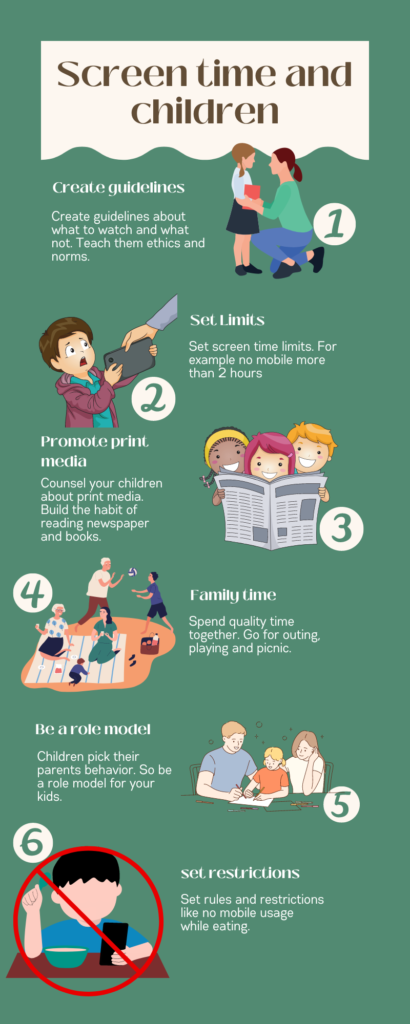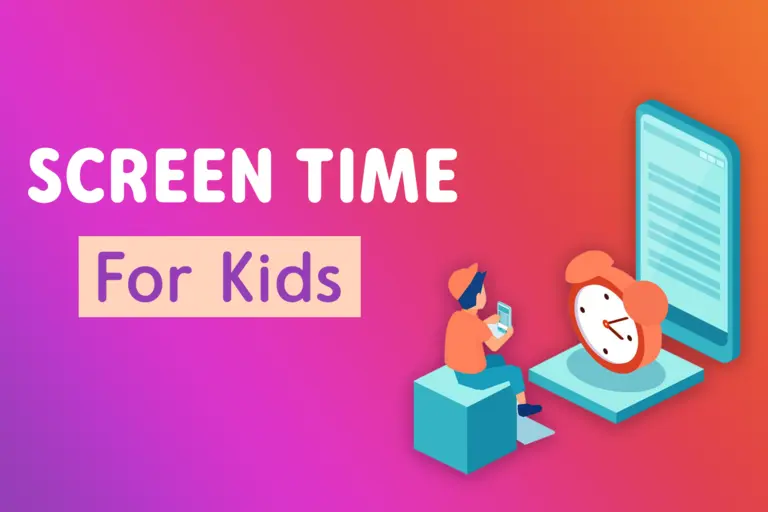How to limit screen time for kids, Useful Advice for Parents
Learn how to limit screen time for kids and reduce the adverse effects of excessive device use. Get practical tips to help your family.
As screen time has become a necessary component of modern childhood, too much of it can harm a child’s growth and well-being. This post will discuss the value of limiting children’s screen usage and offer advice for parents and other caretakers. Whether using smartphones and tablets, playing video games, or watching TV, finding the correct balance is essential to promoting good behaviors and ensuring kids grow up to be healthy adults.
The problem with screens
The adverse effects of excessive screen time on the physical and mental well-being of a child have continued to grow. It led them to considerable sedentary behavior, reducing the time spent on active time. This will also affect the sleep pattern and social interaction of a child. Thus, there is a need to regulate the amount of screen time that would help prevent these issues and promote a balanced lifestyle.
Furthermore, constant exposure to screens affects a child’s cognitive development and ability to learn. A child becomes less attentive and cannot concentrate on something that needs critical thinking. Managing your child’s screen time will allow you to give him activities that will generally foster his development.

How to help children with limit screen time
The American Academy of Medicine is keen on limiting screen exposure in children for their good since such exposure would negatively affect their physical health, sleep patterns, and mental development. This might be achieved by creating clear limits on screen exposure and pushing for other interests such as reading or games outside. It equips the child with deciding choices as the child is encouraged to become digitally literate and to responsibly use the screens.
Setting ground rules for limiting screen time
To manage your child’s screen time appropriately, clear and consistent rules and regulations on-screen use must be determined. Identify areas in your house that should not have any screens, such as your child’s bedroom. Develop a family media plan that specifies when and how screens are allowed and sets appropriate time limits as well as types of content allowed.
Talk with your child about the need for balance in screen time and other activities, such as outdoor and reading time. Discuss how screens are impacting their well-being and help them understand the benefit of setting limits on their on-screen use; this can be a good strategy in teaching skills of self-regulation by getting them involved in creating rules on screen time.
Controlling things older kids can do
The amount of screen time recommended for young children needs readjustment as they grow up. It is important to continue the discussions on the responsible use of screens with older children and the potential consequences that may unfold when screen time exceeds appropriate limits.
This you can do using tools like the Family Link app to track and limit screen time, set time limits for specific applications or devices, and so on. Encourage older children to think about activities that lead to digital literacy within their lives, such as learning to code or produce multimedia.
With a healthy relationship with screens and technology, you’re providing older children with the knowledge to make smart choices about screen time.
promoting electronic literacy
Screen time can be educational and effective if it is done moderately and in purposeful activities. Let the child also explore learning apps and programs that introduce learning activities and develop new skills. Screen time must be monitored to ensure they view the relevant and enriching content according to age.
Talk to your child about the importance of digital literacy by educating him on how to evaluate credibility on the internet. Screen time encourages critical thinking and creativity, so we should limit screen time
as it presents different problems for the brain to solve. With digital literacy education, your child will be able to use education responsibly in the digital world.
Ensure there is a daily limit.
Set up daily and limit screen time
Parents should make sure to include the children in the decision-making process and explain the rationale for change while introducing time limits on screen usage per day. Involving them will help them discuss reasons why limiting time on screen supports an active body and healthy social relationships and thus easily gain cooperation from their child in following the new limits.
In addition, a routine must be made and schedules set around screen times. This would enable the parents to help them develop good habits concerning screens and avoid too much screen time by setting windows of screen use and during these, breaks for physical activities.
Teaching appropriate behavior
Teaching the proper behavior about screen use to children is a very important tool in effectively managing their screen time. It is essential for guidelines to be set on putting up with screen etiquette on where to use devices, breaks when used for long periods, and others such as not to be used before bedtime.
The second approach used by parents towards instilling healthy screen use in their children is by modeling alternative, screen-free activities. And thus, the task of teaching their children the balance between activities related to screens and other responsibilities remains behind their shoulders.
Do not make compromises in parenting.
It may be tempting to weaken those bounds on how many minutes are spent staring at a screen for reasons that may seem convincingly potent at the time, but parents need to be firm and stubborn about those limits. Consistency is key in regulating child screen time, and parents have to stand by the rules they have created to achieve the proper balance in the household.
Parents should also communicate to other caregivers, perhaps even family members or babysitters, the reason that proper limits for screen time are needed:
“We all need to limit her screen time because it’s interfering with her life and yours as well.” This makes parents even more likely to be in alignment with other adults responsible for a child’s safety and creates a conducive environment for the child.
Grow their interest in print media.
Encouraging children to read and enjoy printed media can reduce the number of times they feel glued to screens and diversify their interests. Parents can introduce age-appropriate books, magazines, and newspapers, creating an affinity for reading and expanding knowledge beyond digital walls.
Shared reading, for instance, can encourage children to read more by creating a cozy nook to read or specific reading areas in the home. Parents can help children habituate to books rather than screens as a source of entertainment and learning through enjoyable and comfortable reading.
In addition, reading can be done with the children to help build a shared interest in print media.
Categorize content they have access to
Monitoring and categorizing the content children have access to on screens is essential in effectively regulating their screen time. Parents should review and approve apps, games, videos, and websites their children use to ensure age-appropriateness and educational value.
By setting parental controls and utilizing built-in device features to filter content, parents can restrict access to inappropriate or excessive screen content. Establishing clear guidelines for permissible content can help children make informed choices and promote responsible screen use.
Change downtime for today.
Almost undoubtedly, downtime schedules should be made appropriately and flexible to suit the child. If you realize that a particular downtime schedule needs to be changed, then be sure to correct it. Flexibility is key since every child has different needs.
Introduce some activities to free time so that your child will be kept active and interested. Engage educational games, arts and crafts, or physical exercises. If you treat downtime as fun and fulfilling, the child will embrace this screen-free time.
Observe how your child will react to the changed schedule during downtime. Good communication is required to understand their preferences while assuring that the changed routine proves convenient for their development and entertainment.
Edit the weekly downtime schedule.
Extend your weekly schedule as your child becomes acclimated to the use of daily downtime by setting some days for more extended periods of screen-free time or engaging in family activities that will bond and encourage physical activity.
Coming up with a downtime schedule for each week can be more structured and varied. This should include outdoor play, game time with the family, or creative projects to motivate your child and minimize dependency on screen time. Be open to suggestions from your child about activities he or she likes, and enhance the downtime schedule.
Reviewing and adjusting the weekly downtime schedule regularly helps you achieve a healthy balance of screen time and other activities for your child. Try to encourage your child to participate in decision-making regarding their downtime schedule.
Take Action
Being proactive about your child’s screen time is very important. It needs clear and consistent limits in the use of the screen to create healthy balance between digital entertainment and other engagements. Tools such as the Family Link app also enable proper monitoring and control over screen time.
Always encourage your child to play outdoor games or go for other activities outside, which will minimize their screen time. You can make family fitness nights fun for engaging in healthy lifestyle exercises. Create a backyard fitness circuit course for easy exercising with fun for your child.
Family Fitness Night
Family fitness nights are a brilliant method for promoting physical activity while bonding with your child. Organize regular family fitness nights and engage in fun exercises or sports activities as a team. This will ensure each member of the family stays fit and maintains memories with your child over time.
Some of the activities that could be offered under family fitness nights include dancing, running relay races, or yoga sessions. Once you draw out your child’s creativity, ask them to pick any activity they like. It makes them have a sense of ownership and is the main reason for enthusiasm in participating in fitness nights.
Backyard Fitness Circuit Course
Create a circuit fitness course in the backyard so your little one would have fun exercising. Create stations with active invitations, like jumping jacks, skipping ropes, or a hula hoop. Challenge your child to repeat the circuit several times. Time your child’s progress for an added challenge.
Get the whole family involved in designing and participating in the backyard fitness circuit course to foster teamwork and bonding and encourage your child to be more active outside. Ensure that the circuit course is attractive and challenging enough so that your child is interested in following it.
Recess at Home
Recess at home is a good addition of active physical activity to your child’s day schedule. Prepare a play area where your child can spend time playing active games during breaks from screen time, such as tag, hide-and-seek, or ball games.
Designate a time of the day to have recess back home. This shall ensure that your child gets enough exercise. This is not only to reduce their screen time but also to ensure that they become healthy and developed. Involve yourself in it to ensure that the whole family enjoys the recess time.
Considering the Kid’s Maturity
Explain the Health Issues Related to Limiting Screen Time
The number of limits should be the extent to which the child can be given due to their age and maturity levels. The child is more limiting if at a tender age, whereas relatively fewer factors are required for older kids compared to the former.
The level of screen time that you will permit your child depends on how much you think your child is ready enough to use technology responsibly. With the understanding of your child’s maturity, you can put in place suitable restrictions that will help in striking a balance between screen time and other kinds of activities.
The parent-set limits should, therefore, align with advice from bodies such as the American Academy of Pediatrics. Such guidelines give parents more ideas on the different screen activities that are suitable for a child at different developmental stages.
In other words, one is assured that by using their children’s screens, the latter will not leave at the mercy of evil people their general welfare.
Parents should be well aware of the health-related implications if their children spend too much time in front of screens. Too much exposure to screens exacerbates many health conditions, which include eyestrain, disrupted sleep patterns, and being sedentary.
Parents can serve as powerful promoters of healthy habits for their children by restricting the use of screen time and encouraging healthy lifestyles.
Encourage Physical Activity
Besides managing the screen time, parents should ensure the promotion of physical activity amongst children. The regular performance of physical activity does much good for the health and well-being of a child.
Getting kids to participate in physical activities like outdoor games, playing of other games, or sports can make up for much of the passive nature of screen time. Adding an active schedule to your child will, for sure, help develop healthy patterns benefiting them in both their physical and mental lives.
Being active encourages physical fitness, lifts mood, builds cognitive abilities, and builds social skills. This is what will instill in your child a lifelong respect for fitness and wellness.
Be a Role Model to Your Kids
This includes the role model aspect of parenting. As you would manage the screen time for your child, they often look up to you; hence, it is quite important that you be a good role model at this instance. You can educate your child on the need for a balance and moderation by modeling appropriate use for your own screens and boundaries for your consumption.
You can also open up discussions with your child, so he or she realizes that there are controls that need to be set. Explain to the child why boundaries are set and get them involved in setting decisions – that way, they are empowered to take responsibility for how much time they spend on screens.
You may also reserve shared spaces in the house, such as the living room or dining table, screen-free to limit excessive viewing time and promote meaning in family interaction.
Wrap up
Parents and others in charge have to regulate the screen time their children display with thoughtful planning and innovative activities. By monitoring usage, enforcing realistic limits, and offering choices, we can empower our children to develop healthy screen use habits that can positively contribute to their general well-being. Keep in mind that this is not an end to or obliteration of the screens but a balance of screen use and fun.







